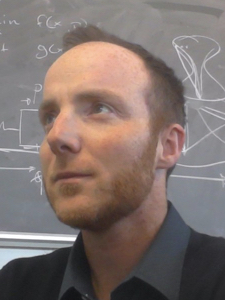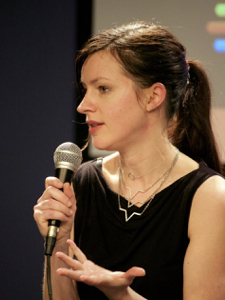Cross-Cutting Challenges: Theme 1
The 2018 Haptics Symposium will feature two Cross-Cutting Challenges sessions. The goal of this set of sessions is to come together to focus on interdisciplinary challenges (“themes”) calling for united solutions from the haptics community. This year's first CCC theme is Expanding Sensory Interactions: The Path to Intelligent Clothes and Objects Able to Change the Way We Communicate With the World.
This session will take place from 8:45 a.m. to 12:30 p.m. on Sunday, March 25, in the California rooms at the Westin St. Francis.
Keynote Talks

Keynote:
Wearable haptics: from VR/AR to human sensorimotor enhancement
Speaker:
Domenico Prattichizzo - University of Siena and Italian Institute of Technology (IIT), Italy

Keynote:
VR haptic controllers: multi-purpose handheld haptics beyond vibro-tactors
Speaker:
Hrvoje Benko - Oculus Research, USA

Keynote:
Surprising facts about the biomechanics and the biotribology of skin — the foundations of wearable haptics
Speaker:
Vincent Hayward - University of London, UK, and Actronika SAS, France

Keynote:
Large-area, soft, wearable haptics: challenges and opportunities of smart clothing
Speaker:
Lucy Dunne - University of Minnesota, USA
Interactive Discussions

Interactive Session:
A fabric-based approach for wearable haptics: neuroscience, emotions and system design
Speaker:
Matteo Bianchi - University of Pisa, Italy

Interactive Session:
Loosely-fitting tactile jacket with vibrator clusters
Speaker:
Akihito Noda - Nanzan University, Japan

Interactive Session:
Wearables for sensory communication
Speaker:
Hong Z. Tan - Purdue University, USA

Interactive Session:
Wearable robotics in clinical neuroscience
Speaker:
Simone Rossi - University of Siena, Italy

Interactive Session:
Arm-worn tactile displays
Speaker:
Katherine J. Kuchenbecker - Max Planck Institute for Intelligent Systems, Germany

Interactive Session:
Integrating electronic systems into textiles and apparel
Speaker:
Meg Grant - Seismic, Inc, USA

Interactive Session:
Body-grounded soft haptics
Speaker:
Allison M. Okamura - Stanford University, USA

Interactive Session:
The path to wearability: the challenge of designing human-symbiotic robotic devices
Speaker:
Antonio Frisoli - TeCIP Institute, Italy

Interactive Session:
Wearables: haptic interfaces and multipurpose input devices
Speaker:
Leonardo Meli - University of Siena, Italy

Interactive Session:
Wearable haptics for virtual and augmented reality: applications in the entertainment and robotic fields
Speaker:
Claudio Pacchierotti - CNRS, France

Interactive Session:
Enhancing human performance with wearable haptics
Speaker:
Marcia O’Malley - Rice University, USA

Interactive Session:
Visionary requirements for wearable haptics: what far-out applications will need from materials and textiles science
Speaker:
Karon MacLean - University of British Columbia, Canada

Interactive Session:
Garment-based Electronics and Actuation for Haptic Displays
Speaker:
Brad Holschuh - University of Minnesota, USA
Description
Research on haptic interfaces has historically developed around grounded kinesthetic devices. The pursuit of more wearable technologies led next to the development of exoskeletons. Although exoskeletons can be considered wearable, they are often quite heavy and cumbersome. More recent research has sought to extend the definition of a “wearable device” beyond something merely suitable to be worn. A wearable haptic device should also be small, easy to carry, comfortable, and it should not impair the motion of the wearer. But wearable haptics is not only applying haptic stimuli in a seamless way. Recent advancements in textile engineering are showing remarkable results in innovative smart clothes, which embed lightweight and thin sensors, either haptic or inertial. For example, Levi’s and Google developed a haptic jacket that enables the user to control their smartphone by touching an instrumented sleeve.
We embrace the idea of service technology that Parviz, Lee, and Thrun shared while presenting Google Glass: “We think technology should work for you — to be there when you need it and get out of your way when you don’t.” Similarly, the concept of extreme unobtrusiveness is at the core of wearable haptics.
To achieve such an ambitious goal, we need to pursue a deeper understanding of our sense of touch, as well as the discovery of innovative technological solutions at its interface. The need for small and lightweight – but effective – technology requires remarkable competences in various fields:
- biologists, physiologists, neuroscientists to understand sensory transduction, muscle, and neural afferents and how our brain interprets their transmitted information;
- designers, artists, interaction experts to explore new ways and approaches to human-device interaction, in terms of visual appearance, fashion, comfort, and intuitiveness;
- mechanical, electrical, and material engineers to design and develop suitable mechanisms, textiles, and machines able to elicit and/or sense effective and informative touch sensation;
- computer scientists to design proper haptic rendering and sensing algorithms;
- psychophysics experts to evaluate the effectiveness of our haptic systems.
Recently, Elon Musk told an audience at the Dubai World Government Summit that “over time I think we will probably see a closer merger of biological intelligence and digital intelligence.” In an age when AI and autonomy are becoming widespread, there is a growing need to empower human interactions through new intelligent devices. Nowadays, we have small wearable devices able to apply compelling haptic sensations as well as comfortable instrumented garments able to sense inputs coming from the human wearer (contact forces and motion). In the future, we foresee an advancement of these technologies toward more wearable and seamless solutions, until their complete blend and merge in what we call “wearable sensorimotor interfaces”. These novel interfaces will be able to sense user input and biometric information, and to apply haptic and other stimuli in an extremely seamless and comfortable way. This will be the first step toward a new field of research that can dramatically enlarge the potentiality and applicability of haptics to enhance human capabilities, health, and human interaction with digital information. Future applications may be in mixed and augmented reality, human sensory augmentation (e.g., extra limbs), assistance to elderly and disabled people, and natural control of intelligent devices (e.g., Internet of Things, smartphones).
Organizers
 |
 |
 |
||
|
Domenico Prattichizzo |
Claudio Pacchierotti |
Leonardo Meli |


